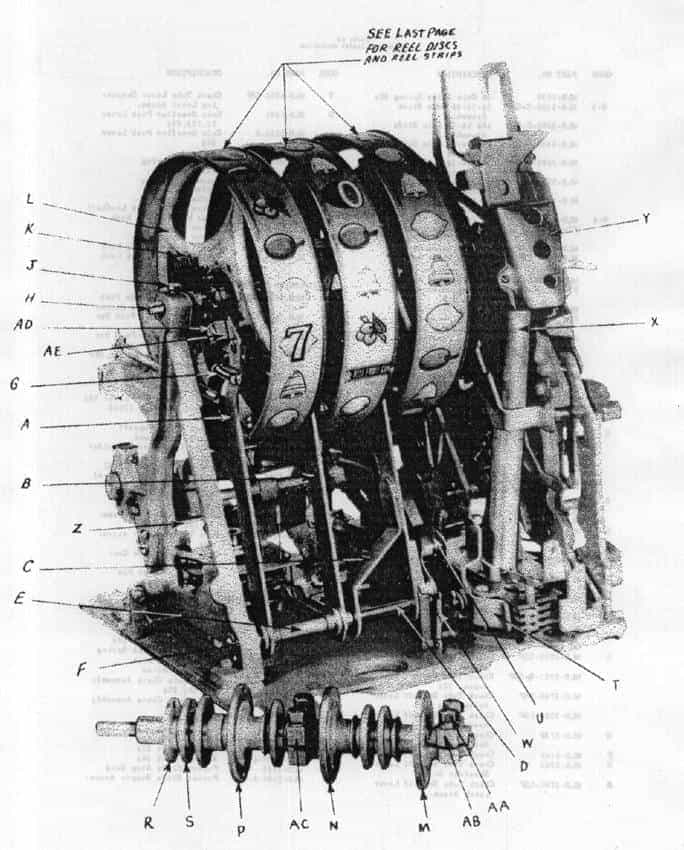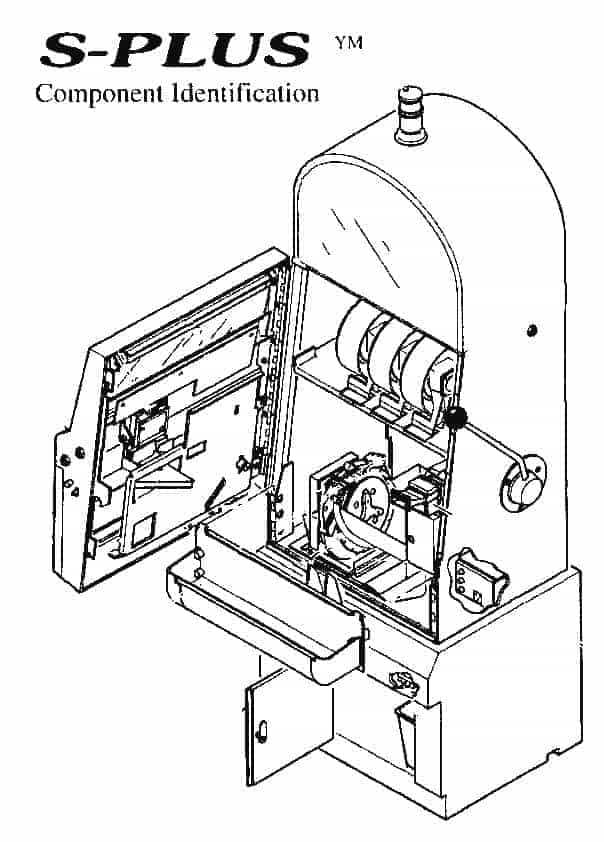It started back in the time of the first modern slot machine from Fey. Players wanted to know how the slot machine works and whether they reliable be. At the end of the 19th century, someone else was standing next to the closet. That person operated the device and made any payouts. Surely such a man can easily adjust the payout percentage with a screwdriver, was the idea. Not really. To change the win rate of such a mechanical slot machine, you need to largely disassemble it. You have to replace the discs with the symbols and their reels. That's quite a labor-intensive job. A mechanical slot machine consists of dozens of feathers of different sizes. And more than 500 parts. Changing even one symbol can take up to three hours.
How does a physical old-fashioned slot machine work?

Interior of the 1947 MIlls Bell (from the manual)
A slot machine works on the principle of a start, spin discs with symbols, accelerate, stop and pay out or not. In the old-fashioned slot machine, everything works completely mechanically. So with Gears, pallets, lugs, springs, deep and less deep slots and the like. The base of the slot machine is formed by a metal axis with the discs. On one side of this axis there is a lever. With this, a player sets the discs in motion.After the discs rotate for a while, a stopping system provides braking. Simply by, for example, pushing a pallet forward, which thereby hooks in an arbitrary place behind a tooth of the gear of a disk.The payout mechanism is constructed in such a way that it pays out when the discs are in a certain position. For example, with a winning combination, a pallet goes deeper into the gear of the disc. This allows a flap attached to the pallet to spring up. As a result, the won coins fall into the money box. In the case of a non-winning combination, the cover remains down.
Adjustments and own solutions
As we could read in the history of the slot machine, Charles Fey figured out that the tension of the game is increased when the discs with the symbols do not stop at the same time. The player then only sees when stopping the last disc whether he has won something. In order to implement this psychological game element, Fey had to come up with a solution to the stop mechanism.In the same way, manufacturers were constantly improving the mechanics of the slot machine. Not necessarily to add a game element. Often it was simply about being able to build more efficiently, make it more compact or circumvent patents.Those modifications to the mechanical slot machine grew with technological developments. Gradually, as a result, there were several ways to move the discs, read the win or loss result, control the payout and perform other things in the slot.
Electric slot machine

Interior of IGS S-series from 1986 (from the manual)
In the mid-thirties, the first electric slot machine appeared. It had a button instead of a lever, an electric motor for control, and it continued to work with an air pressure system. Pushing the button everywhere was a problem. Many players thought that they influenced the game with their personal way of pulling the lever. The lever remained.But in the closet, electric motors did gradually replace the old-fashioned drive mechanism of the discs. And electromagnets controlled the stopping system. The rest of the mechanics changed little. An electric slot machine was about using electricity and replacing mechanical parts with electrically powered parts.
Electronic slots
In the early sixties came the first electronic slot machines. An electronic slot machine used circuits. Such a circuit consisted of a circuit board with transistors, diodes, resistors and the like. Simple commands could be executed with it. The first electronic slot machines could also be called electromechanical. They operated on electricity and had mechanical parts controlled by electronics. The electric motor, for example, was replaced by a stepper motor. This was controlled by a circuit that powered it with short electrical pulses, much more meticulously. Gradually, the mechanical and electrical parts were increasingly taken over by electronic parts. And there came integrated circuits, or microchips. The slot machine was approaching the computer age. With the advent of Electronics, not only the operation of the slot machine changed. It also enabled new features. For example, there were more winning combinations, and the device accepted several types of coins.
Video slots
In the late seventies, the first slot machine with video appeared. The video image replaced the mechanically rotating discs. These were subsequently recreated in a video animation. The cabinet remained large due to the then still large picture tube, but when the screen could be flatter, a psychological issue also played here. Players would certainly object in those early days. Manufacturers therefore imitated the old-fashioned cabinet as much as possible, including in the images shown on the screen.
Computer and internet
The modern slot machine nowadays consists of a complete computer, in which no or hardly any mechanical parts are required. The computer controls all the necessary actions of the slot machine. In the computer, among other things, there is an RNG (Random Number Generator) chip. This causes the graphic disks with symbols to stop at random. The computer and later the internet again offered new possibilities. Previously al become slot machines linked together in a space. For example, a progressive jackpot over several cabinets was realized. Thanks to the internet, this is even possible over a longer distance. And with the internet, the computer game could be taken from the physical slot machine to the living room. Online gaming has become a reality.